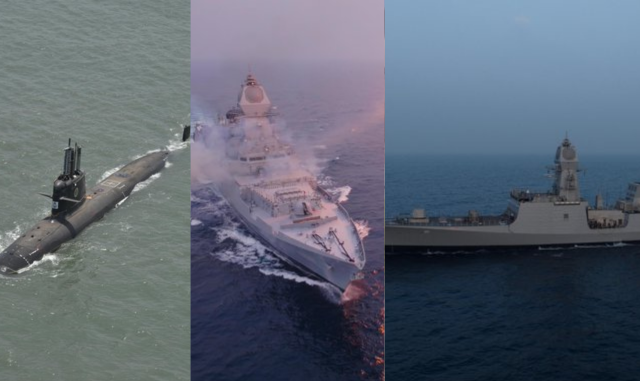Table of Contents

Introduction
On January 15, 2025, Prime Minister Narendra Modi inaugurated three cutting-edge naval assets—INS Surat, INS Nilgiri, and INS Vagsheer—at the Mazagon Dock Shipbuilders Limited (MDL) in Mumbai. This significant event underscores India’s maritime defense strategy and its commitment to self-reliance in military production. These additions to the Indian Navy’s fleet strengthen Indias maritime defense capabilities, ensuring the nation remains prepared to tackle emerging regional and global challenges.
INS Surat: A Modern Guided Missile Destroyer
INS Surat, the final vessel of Project 15B, is a testament to India’s growing expertise in naval shipbuilding. This Visakhapatnam-class guided missile destroyer is a vital addition to India’s maritime defense, showcasing advanced design and firepower.
Specifications and Features:
- Dimensions: 163 meters in length, 17 meters in width.
- Speed: Capable of reaching speeds of up to 30 knots.
- Indigenous Content: Approximately 75%.
- Weaponry:
- Medium Range Surface-to-Air Missiles (MRSAMs).
- BrahMos supersonic cruise missiles.
- Indigenous torpedo tube launchers and anti-submarine rocket launchers.
With cutting-edge stealth technology and the ability to accommodate two helicopters, INS Surat enhances India’s maritime defense by providing unparalleled combat capabilities and operational flexibility.
INS Nilgiri: The Advanced Stealth Frigate
As the lead ship of Project 17A, INS Nilgiri sets new benchmarks for advanced frigate design. It integrates enhanced survivability, stealth, and maneuverability features, making it a cornerstone of Indias maritime defense strategy.
Specifications and Features:
- Dimensions: 149 meters in length, 17.8 meters in breadth.
- Speed: Maximum speed of 28 knots.
- Weaponry:
- Eight BrahMos supersonic cruise missiles.
- 32 MRSAMs.
- Torpedoes and Kavach chaff launchers.
- A 76mm gun for surface engagement.
The frigate’s future upgrades, including the indigenously developed VL-SRSAM missile system, ensure it remains a critical asset for Indias maritime defense for years to come.
INS Vagsheer: A Next-Gen Submarine
INS Vagsheer, the sixth and final submarine of the Kalvari-class, reflects India’s mastery in submarine technology under Project 75. Developed in collaboration with the French Naval Group, the submarine strengthens Indias maritime defense by adding unmatched versatility to its naval fleet.
Specifications and Features:
- Tonnage: 2,000 tonnes.
- Versatility: Capable of long-range strikes, special operations, and intelligence gathering.
- Future Upgrades: Modular design supports the integration of air-independent propulsion (AIP) systems, enhancing underwater endurance and operational capabilities.
By commissioning INS Vagsheer, India demonstrates its ability to independently develop advanced submarines that meet the demands of modern naval warfare, a key aspect of Indias maritime defense.
Strategic Importance of Indigenous Defense Production
The commissioning of these vessels reinforces the core of India’s maritime defense—a robust and self-reliant naval force. Built entirely in India, INS Surat, INS Nilgiri, and INS Vagsheer symbolize the success of the “Make in India” initiative and underscore the nation’s ability to meet its defense needs independently.
As tensions rise in the geopolitically significant Indian Ocean, Indias maritime defense becomes even more critical. These new platforms provide the Indian Navy with the strategic depth needed to deter threats, safeguard economic interests, and ensure the security of critical maritime trade routes.
Defense Minister Rajnath Singh emphasized the growing focus on the Indian Ocean and highlighted the importance of a strong naval presence to protect sovereignty and foster regional stability.
Looking Ahead: Future Naval Initiatives
India’s future naval strategy includes plans to expand its submarine fleet through the construction of three additional Scorpene-class submarines. These will be developed under an Indo-French collaboration, further enhancing Indias maritime defense capabilities. Although the first of these submarines is expected to be operational only by 2031, the deal marks a significant step in bolstering India’s naval strength.
Geopolitical Implications
The commissioning of INS Surat, INS Nilgiri, and INS Vagsheer signals India’s readiness to address evolving maritime challenges and strengthen Indias maritime defense posture. With increased naval activity in the Indian Ocean, these assets enhance India’s ability to safeguard its interests and contribute to regional stability.
By focusing on indigenous defense production, India not only reduces its reliance on imports but also positions itself as a leader in maritime security. These initiatives are vital to asserting India’s role as a major player in global geopolitics.
Conclusion
The induction of INS Surat, INS Nilgiri, and INS Vagsheer into the Indian Navy underscores India’s unwavering commitment to strengthening Indias maritime defense. These vessels exemplify the nation’s technological and industrial advancements while highlighting its strategic foresight in protecting its maritime interests.
As India continues to enhance its naval capabilities, these platforms serve as a testament to its determination to secure sovereignty, foster regional stability, and assert its presence on the global stage. Indias maritime defense is not just about naval assets but about a vision for a secure and prosperous future.
1 thought on “Strengthening Indias Maritime Defense: PM Modi Commissions INS Surat, INS Nilgiri, and INS Vagsheer”